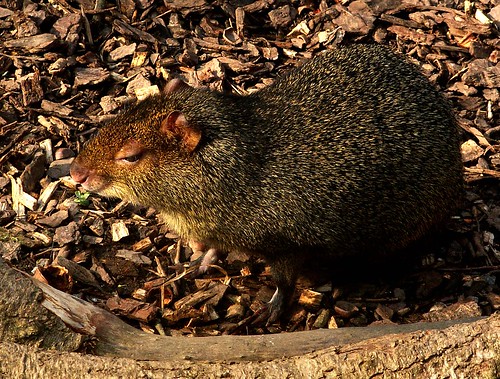That darn agouti, courtesy of Ennor
In the environmental campaigning world, we talk a lot about the need to protect biodiversity: how it’s important to beat the ballooning extinction rate and preserve as many different species as we possible. Not only that, we need populations large enough to contain a deep genetic pool so they can breed successfully.
Anyone with the slightest interest in conservation accepts that we need to save trees, animals, slime molds, whatever from the great natural history museum in the sky, but the word ‘biodiversity’ itself causes me some problems. I don’t have any evidence to back this up (if anyone does, let me know) but I suspect it’s one of those jargon words used in policy documents and scientific abstracts which doesn’t really mean anything to those outside a relatively small circle who are in the know.
Some people have recently warned about the overuse of green geek speak and how it may be alienating the very people we’re trying to reach. Speaking as someone whose job it is to communicate environmental campaigns – many of which are based on rigorous research and reporting – to as wide an audience as possible, this really matters. Talking about the benefits of genetic diversity is guaranteed to turn a lot of people off and there have been times when I’ve deliberately avoided using ‘biodiversity’ in some stories I’ve written.
But then I just come up against the problem of which word to use instead. ‘Wildlife’ gets more Google hits but doesn’t really cut it; ‘plants and animals’ is lumpen and ignores whole kingdoms on the evolutionary tree… In fact, nothing I can come up with reflects the feverish complexity inherent in ‘biodiversity’.
As with anything, if you want people to understand the best way is to show them and as the interdependences of living organisms are slowly unpicked, there are more and more examples to draw on. Recently, I read Colin Tudge’s excellent book, The Secret Life of Trees, a fascinating insight into the mind-boggling wonder of our arboreal friends. (I making assumptions that trees have friends, because they never write, the never phone…) If you haven’t read it, do so (but save a tree and get a secondhand copy).
Amongst the many examples of trees relying on other living things (including a large section on the truly incredible fig-wasp interface), there’s the story of the almendro tree which grows in Panama. This tree produces a fruit, often in large quantities, which brings hordes of creatures to feast on them. The problem is, most of the diners aren’t very good at dispersing seeds (there are good reasons why tropical trees need to be so far away from other members of the same species – read the book to find out why). So the almendro relies on bats, who disperse the seeds but don’t bury them. The tree also relies on agoutis, a relative of the guinea pig, which finds seeds dropped by the bats, eats most of them but also buries some for later consumption, just like a squirrel. Given a chance, these planted seeds will germinate and grow.
But a further problem is that agoutis will also eat the young almendro shoots, so these rodents need to be kept in check. That’s where the ocelots come in – they keep the agouti numbers down and so the juvenile almendro have a better chance of surviving. Almendro trees haven’t been reproducing very well and the theory is that the low number of ocelots is having a direct impact on them – fewer ocelots means more agoutis which means fewer almendros. Kill off the bats and the agoutis, and it’s obvious that the trees are gonna suffer but where the ocelots fit in is less apparent, but take them out and the whole web would unravel anyway.
I know it’s not exactly revelatory, but reading that passage helped put a new angle on my understanding of biodiversity, a least the concept if not the detailed scientific analysis. It’s over-simplifying for sure and there are bound to be other species involved in the success story of almendros, but it’s a neat illustration of why biodiversity is important, not just for its own sake but for the continued survival of every species, including us. Now if I can just work that in every time I need to use the word ‘biodiversity’, I’m sorted.
